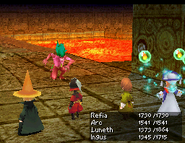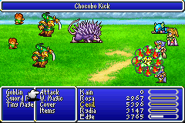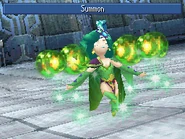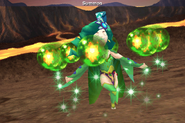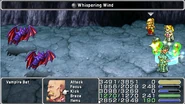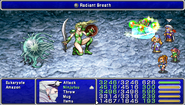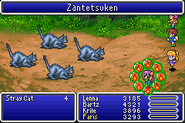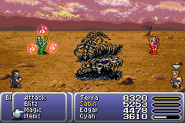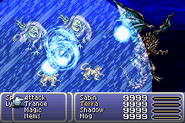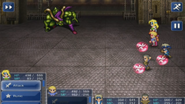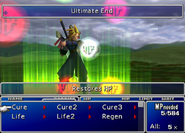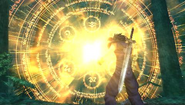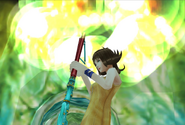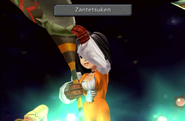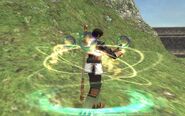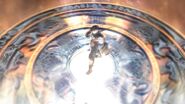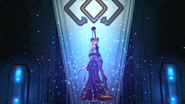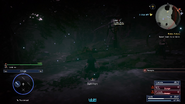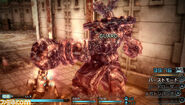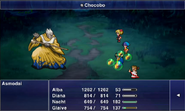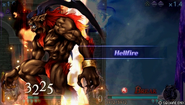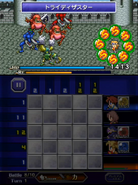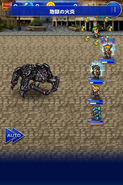
I couldn't miss the chance to practice my drawing!
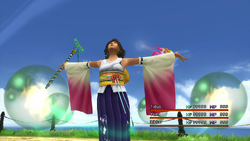
Yuna, performing a summoning ritual in Final Fantasy X.
Summon (召喚 or サモン, Shōkan or Samon?), also known as Call (よびだす, Yobidasu?), Conjure, Summon Magic, Summoning Magic, or Summoning, is a recurring command ability in the Final Fantasy series. It lets the user call forth summoned monsters into battle.
In the oldest Final Fantasy games, whenever the player summons, flaming green orbs float out or encircle the player character preceding the selected summon's appearance. Depending on the game, the summoned monster attacks and then leaves, or stays and continues to attack until it's defeated or its time runs out. From Final Fantasy XII and Final Fantasy XIII onwards, the flaming green orbs do not appear, and are replaced with a character animation of the summoning, or a seal where the summon emerges from.
Appearances[]
Final Fantasy II[]
Even though summoning never appears as a command, a Wyvern can be summoned with the use of an item. However, the 20th Anniversary edition added the Arcane Labyrinth sidequest, which holds a strong allusion to this ability. Deumion, the main character of this sidequest's subplot, has the ability to summon holy creatures, such as Phrekyos.
Final Fantasy III[]
Summon can be used by the Evoker, Sage, and Summoner jobs, with different effects. Evokers randomly summon an "offensive" or "defensive" attack from a chosen summoned monster. Offensive attacks may deal damage, while defensive attacks usually buff up, heal the party, or inflict status effects on all the monsters.
The Summoner can summon them at full power, dealing massive damage to the entire enemy party. Sages cast the Summoner versions of Summon spells in 2D versions of the game, and Evoker versions of the spells in the 3D version.
Final Fantasy IV[]


Rydia can summon (Call on the SNES) Eidolons to deal massive damage against enemies. The Summon command's Charge Time varies, and its charge time it taken from the spell the player selects to cast.
Final Fantasy IV -Interlude-[]
Rydia can summon Eidolons to aid the party during battle. Impostor Rydia also has this ability for the time she spends with the party.
Final Fantasy IV: The After Years[]

Rydia can summon Eidolons but starts with none, and only begins to get them in the final chapter. The Summon command's Charge Time varies, and its charge time it taken from the spell the player selects to cast.
Final Fantasy V[]


Summon command is learned by the Summoner class and calls forth a summon beast for varying effects. The Call command randomly selects a summon in the party's possession and summons it for no MP cost.
Leveling up the Summon command allows other jobs to also call forth increasingly better summons, and also boosts the job's base Magic Power.
Final Fantasy VI[]
Summoning espers is accessible as long as a character is equipped with magicite, by selecting the Magic command and pressing the Control Pad upwards while at the top of the list. All summons have unblockable attacks that cannot be reflected, but can only be summoned once per battle. Characters cannot summon if they are equipped with the Soul of Thamasa relic.
There is a dummied command called "Summon" only be accessed via hacking the game. It would have allowed the player to summon their equipped esper over and over during the same battle as long they have enough MP, but due to a glitch in the code, it can only target the party, and the only espers that can be summoned through this command are those that target the party.
Final Fantasy VII[]
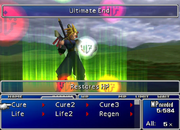
Summoning.
Summon command is accessible as long as a character is equipped with Summon Materia. The times the summon can be called is dependent upon the Materia's level, although using the Master Summon Materia allows a character to summon anything, any time, any given number of times in a single battle, as long as they have the appropriate MP.
When summoning, characters are surrounded by a flash of light. Several spheres of color with strange symbols float up while the character stretches out their arms. They disappear just before the summon performs its attack.
Cait Sith can also use his Limit Break ability as part of the Slots, which allows him to summon for no MP cost. The higher the level, the better the chance of achieving higher summons. While Knights of Round is possible at higher levels, there is only a very small chance.
When summoned with Cait Sith's Limit Break, the ability names refer to the summon's name, as opposed to the ability name, so Titan would be called Titan instead of "Anger of the Land". Exceptions to this are "Gunge Lance" and "Fat Chocobo", which are secondary abilities of Odin and Choco/Mog, respectively.
Final Fantasy VII Remake[]
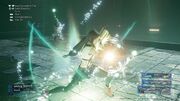
Summon command.
The summon command is available when a character has a summoning materia equipped. Summons cannot be used at will, and require special conditions to be activated. One of them requires characters to sustain damage during battle. During boss battles summons can be used once the boss takes a specific amount of damage. If either condition is met, a Summon Gauge appears, with a set time required before the summon can be invoked. Summoning requires ATB, and can be used once per battle. Certain Summons can only be used in specific boss battles, while others can be summoned at any, including against normal enemies. The size of the summon is a factor in which fights it can be summoned in; the smaller DLC summons can be used in any fight where summoning is possible, while larger summons are limited to more open arenas. If no summons that are compatible with the arena are equipped, the Summon Gauge will not appear.
Once invoked, the summon will fight as an independent ally, but special actions can be activated by any character with the required ATB gauge(s). Once the time limit is reached, the summon will execute its ultimate attack before departing. The summon also uses its ultimate attack if the summoner is KO'd.
Final Fantasy VIII[]
The GF command appears when a character has junctioned a Guardian Force with the command and has equipped the command to be used in battle. The GF is not summoned right away; a second ATB bar appears over the summoner's, and when it depletes the summon activates. The GF's HP replaces the summoner's for the duration of charge time, and if the GF's HP is depleted, the summon is canceled, and the GF cannot be summoned until it is healed. Charge time can be reduced by raising the summoner and the GF's compatibility. If the GF knows Boost, the player can tap a button during the summon animation to increase damage.
The GF command is a default command to every GF, but if a player removes it with an Amnesia Green, they can get it back by using a GF Scroll.
Final Fantasy IX[]

Eiko and Garnet summon Alexander.
Summon eidolons.
Description
The Summon command is used by Dagger and Eiko with each having access to different summons. In Trance, Dagger's summon command is called Eidolon (幻獣, Genjū?). In this mode, an eidolon called by her will randomly appear to attack even after it has been dismissed after its initial summoning. Summons' power is determined by animation length, support abilities in use, number of jewels the eidolons have an affinity to in stock, and for Eiko, which add-on she has equipped.
The Mimic can also call forth a minion through the Call command. A Mimic will call a Magic Vice to assist them in battle. If the Magic Vice is defeated, only then will the Mimic use the same command again.
Final Fantasy X[]

Storyboard.
Summon an aeon.
Description
Yuna has access to the summon command. When she summons an aeon, the rest of the party leaves the area; even KO'd allies will get up and leave, promptly collapsing back to the ground should they reenter, while petrified allies simply fade away temporarily. There are both "full" and "short" animations for aeon summon sequences and Overdrive attacks; however, the difference is cosmetic. When setting "Aeons" to "Short" in the Configuration menu, each aeon's full summon and Overdrive animations will only be shown the very first time.
After being summoned, the player controls the aeon who will act like a regular character in battle, with its own HP and stats. Aeons are immune to status effects (except Curse and Delay) and some can absorb a certain element. They can be dismissed either through the Dismiss command, or if the aeon dies, in which case the aeon can't be summoned again during the same battle.
Yuna's Grand Summon command Overdrive summons one of her aeons with a full Overdrive bar overlaying their regular gauge, meaning their previous gauge isn't wasted.
Belgemine calls Ifrit into battle on the Mi'ihen Highroad, Ixion in the Moonflow, and Shiva in the Calm Lands. She also has the opportunity to summon all of her aeons in Remiem Temple. Isaaru can summon Valefor, which he calls Pterya; Ifrit, which he calls Grothia; and Bahamut, which he calls Spathi. Ginnem similarly summons Yojimbo in the Cavern of the Stolen Fayth, and Seymour can summon Anima. In the International, PAL, and HD Remaster releases, Bevelle's summoners summon the Dark Aeons the player can battle as optional bosses.
Final Fantasy XI[]
Summoners and characters with Summoner as their secondary job have access to the blood pacts they have earned. The summoned creatures are considered their own spell and are unable to be called in the event the summoner is silenced.
Final Fantasy XII[]
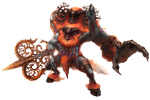
Belias, the first summon.
The Summon command is found under the option Mist and enables a character to summon the Espers acquired in the License Board. Summoning an Esper is similar to using a Quickening; the Lv 1 Espers take one MP bar to summon, whereas the Lv 3 Espers take all three. The action is instantaneous and takes no Charge Time.
When an Esper is summoned, the two other party members disappear, and the battlefield is shared by the Esper and its summoner. The theme is replaced by the "Esper" track as long as the Esper is present. The Esper's level is identical to its summoner's, so their stats grow in the same manner. Though, they have fixed Attack, Defense, and Magic Defense (like wearing the same "equipment"). Each summon lasts a maximum of 1:30 minutes and ends when either the summoner or the Esper dies, the Esper is dismissed, or the Esper uses its ultimate move.
Espers follow their own gambits that the player can't influence, much like guests. They are immune to almost all negative statuses, and whenever an Esper is on the battlefield, enemies tend to focus their attacks on it. An Esper's basic attacks will never deal hit combos or critical hits, but they can hit flying targets. They can cast magick even if they have no MP, so the player can syphon their MP freely. The ultimate attacks used by Espers are area of effect abilities, which target the enemy with the highest max HP.
In the Zodiac versions, Espers can be controlled directly by the player, and their summon duration is extended to 4:10 minutes. They can use items, though they have no animation for it. They now require MP to cast magicks as well.
Final Fantasy XIII[]
Summon an Eidolon.
Description
The summon command is a technique that costs three TP to use, and allows the party leader to summon their personal Eidolon into battle. Unlike other techniques, which can be learned by unlocking them from the Crystarium, the summon command is learned after the character acquires an Eidolon by forcing them to yield in battle.
The party leader is immune to damage during the summoning animation, which can be used for strategic advantage by timing the summoning right when an opponent is launching its attack. The Eidolon is dismissed if the summoner dies, or it runs out of SP in normal mode, or after using its special attack in Gestalt Mode. After being dismissed, the party appears back on the battlefield with full HP and all status ailments healed. Eidolons can be called upon multiple times during a battle, but as it takes quite a lot of TP, doing so is rare.
When summoning an Eidolon, the two other party members are dismissed and the battlefield is taken by the Eidolon and its summoner. During this time, any role bonuses from the dismissed party members are not in effect. During the battle, the player has a time limit during which they can fill the Gestalt Gauge, which determines the strength of the Eidolon's special attack, and how long a Gestalt Mode they can have. The same attributes affect the Gestalt Gauge build as during first the battle against the same Eidolon. The time limit that determines this first battle phase is the SP gauge. The SP gauge steadily depletes over time, and any attacks the Eidolon sustains are depleted from the SP gauge rather than from an HP bar. When in Gestalt Mode, opponents are unable to attack.
Summon is also an enemy ability that calls a random ally. It is used by Rangda and Verdelet.
Final Fantasy XIV[]
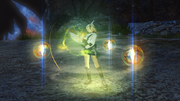
A Summoner summoning Garuda-Egi.
Traditional Summon spells are the specialty of the ![]() Arcanist class and its jobs,
Arcanist class and its jobs, ![]() Summoner and
Summoner and ![]() Scholar. Via dedicated summoning abilities, Arcanists can summon Carbuncles, Scholars can summon Faeries that specialize in healing magic, while Summoners call fractions of a primal's essence called Egis. The
Scholar. Via dedicated summoning abilities, Arcanists can summon Carbuncles, Scholars can summon Faeries that specialize in healing magic, while Summoners call fractions of a primal's essence called Egis. The ![]() Summon ability specifically calls upon Carbuncle for Arcanists and Summoners, which is used as a catalyst for more advanced summons.
Summon ability specifically calls upon Carbuncle for Arcanists and Summoners, which is used as a catalyst for more advanced summons.
Final Fantasy XV[]

Noctis has red eyes whenever he summons.
When summoning becomes available the screen darkens, small white lights appear all around the area, and the battle theme changes. The player can summon by holding ![]() /
/![]() . When this prompt appears depends on the situation of the battle and the severity of the party's health.
. When this prompt appears depends on the situation of the battle and the severity of the party's health.
The player can summon once per battle and each summon can be called around once per in-game day. Each summon has its own requirements to be considered during the "summon roll", which happens every 10 seconds. While possible to summon during the first roll, it is rare. Summoning for the first time earns the Divine Intervention achievement/trophy.
The summoning prompt only appears when playing as Noctis; the others can't summon. The player can summon when in Lucis, either on the overworld/dungeons or in Insomnia (bar the boss battles in Chapter 14 besides the scripted sequences). Titan and Leviathan can only be summoned in certain locations.[1] The summon prompt never appears in Altissia, Fodina Caestino, Eusciello, Ghorovas Rift, Gralea, Zegnautus Keep, menace dungeons or in training sessions. The player can summon in Timed Quests and while Noctis is confused.
Final Fantasy XV Episode Duscae[]
After acquiring Ramuh from Fociaugh Hollow in the southeastern part of Duscae, Noctis can summon him to battle while at 0 HP by holding down ![]() /
/![]() . Summoning is disabled inside caves.
. Summoning is disabled inside caves.
Final Fantasy Type-0[]
Summoning appears in the form of Eidolons, powerful beings which can be controlled for a short period of time at the cost of the summoners life. Summoning requires holding down the two assigned buttons for half a second, which creates a portal (assuming there's enough space for it to appear). Eidolons can only be summoned during missions.
Final Fantasy Tactics[]
Summon is a command ability learned from the Summoner job class. The unit must have learned at least one summon by spending JP. The summon is not unleashed immediately, but will involve a charge time.
The amount of charge depends on the selected summon, the stronger the longer. The original English version had reduced the charge time of all summons, but was reverted to the same as Japanese version in the The War of the Lions port.
Final Fantasy Tactics Advance[]
Summon is a action ability learned by the Summoner job. Summons are learned via staves.
Final Fantasy Tactics A2: Grimoire of the Rift[]
Summoning is a command ability learned by the Summoner job. Staves teach summon magic. Some accessories allow units to summon powerful Espers called Scions, most of which deal damage to all enemies.
Final Fantasy Crystal Chronicles: My Life as a Darklord[]
The main character Mira summons a myriad of monsters and floors in an attempt to defeat invading Adventurers.
Final Fantasy Dimensions[]
Calls forth a random Eidolon without using MP.
Description of Call
Summon is the fixed job command of the Summoner job. It can be equipped on other jobs, occupying 2 ability slots.
Call is a 2 slot ability learned by summoners at job level 18, and allows a random Eidolon to be summoned with no MP cost.
Dissidia Final Fantasy (2008) and Dissidia 012 Final Fantasy[]
Summoning make an appearance in the form of summonstones that can be equipped and used in battles for various effects, for example manipulating Bravery and even breaking the opponent.
In Dissidia 012, a wider range of summons is available. Yuna summons aeons to her aid in battle, using them to perform all of her attacks.
Dissidia Final Fantasy NT[]
Pictlogica Final Fantasy[]
Final Fantasy All the Bravest[]
Rydia, Eiko, and Yuna attack with summoned monsters from their respective games: Rydia summons Mist Dragon, Eiko summons Madeen, and Yuna summons Valefor. Krile has the Summoner's Dualcast which makes her summon both Titan and Odin for her attack.
Final Fantasy Record Keeper[]
Final Fantasy Trading Card Game[]
One of Garnet's cards can use her Eidolon command. For the discard of a Garnet card and payment of any amount of any type of CP, Eidolon lets the player choose up to two Eidolons in their Break zone with a combined cost less than the CP they paid, and for that turn they can be summoned for no cost. The selected Eidolons are removed from the game if they are summoned by this ability.
A card depicting the Final Fantasy XI version of Cait Sith has "Summon [Atomos]" as its ability, usable by Dulling Cait Sith and discarding another Cait Sith card. The ability places all characters in the Break Zone, and allows the player a second turn immediately once their current turn ends.
Non-Final Fantasy guest appearances[]
Bahamut Lagoon[]
The Summon command is an ability for the summoner Yoyo and Sendak who can summon the Holy Dragons to assist the party in their battles.
Trials of Mana[]

The classic flaming orb appears in a variety of colors for Riesz, including the classic flaming green orb. They are used as icons on her ring menu, representing summon spells. Riesz receives one of four unique summons when promoted to her third class.
If the player chooses to send Charlotte on any Dark class path, she will have the ability to summon common foes as allies and thereby damage other foes.
Dead Fantasy[]
Yuna uses her summoning abilities after spherechanging from Gunner to Summoner in Dead Fantasy IV while teaming up with her rival Kasumi against her antagonistic clones. Her summoning ability is based on both Final Fantasy X and her EX Burst in Dissidia 012. She summons her aeons Shiva, Ixion, Ifrit, Bahamut and Valefor to battle the clones, but the aeons are defeated, causing Yuna to revert to her Gunner dressphere.
Behind the scenes[]
In Final Fantasy X-2, during the spherechange sequences for the Mascot dressphere, Yuna, Rikku, and Paine are introduced by their weapons (dolls of a Moomba, PuPu and Cactuar, respectively) mimicking the summoning ritual from Final Fantasy X, complete with four small flaming green orbs.
In the 2000 film version of Charlie's Angels, the two boys are playing Final Fantasy VIII and are controlling Squall and Quistis in a battle in the Training Center. They are fighting against two Grats, and Squall summons Quezacotl.
Gallery[]
Etymology[]
Evocation is the act of calling upon or summoning a spirit, demon, god or other supernatural agent, in the Western mystery tradition. Comparable practices exist in many religions and magical traditions and may employ the use of mind-altering substances with and without uttered word formulas.


